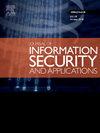Compression-robust detection of Motion-Compensated Frame Interpolation using Discrete Cosine Transform in logarithm domain
IF 3.8
2区 计算机科学
Q2 COMPUTER SCIENCE, INFORMATION SYSTEMS
Journal of Information Security and Applications
Pub Date : 2025-03-25
DOI:10.1016/j.jisa.2025.104044
引用次数: 0
Abstract
Motion Compensated Frame Interpolation (MCFI) is a widely used technique to improve the frame rate of a video sequence in recent years, but it can also be used by forgers for malicious forgery, resulting in a large number of fake high-frame-rate videos. This paper presents how the Discrete Cosine Transform (DCT) is used in the logarithm domain to identify whether a video has been forged by MCFI. First, the DCT is taken on each frame in a suspect video. Then, the DCT coefficients are transformed into the logarithm domain. Finally, the mean of the logarithmic DCT coefficients is computed, and its variation over time is taken as the DCT feature to derive a classifier to realize automatic detection. Since MCFI modifies the majority of DCT coefficients in the high-frequency band, the high-frequency DCT coefficients are significantly enhanced by the logarithm transform, making the DCT feature more sensitive to MCFI modification. More importantly, it is proved through quantitative and qualitative analyses that the proposed DCT feature has the capacity for resisting lossy compression. The proposed DCT feature is used to train different classifiers with a large-scale dataset, and the extensive experiments verify that the proposed DCT feature compares favorably with the state-of-the-art methods while having the robustness to lossy compression.
基于对数域离散余弦变换的运动补偿帧插值压缩鲁棒检测
运动补偿帧插值(MCFI)是近年来广泛应用的一种提高视频序列帧率的技术,但它也可能被伪造者用于恶意伪造,造成大量伪造的高帧率视频。本文介绍了如何在对数域中使用离散余弦变换(DCT)来识别视频是否被MCFI伪造。首先,对可疑视频的每一帧进行DCT。然后,将DCT系数变换到对数域。最后,计算对数DCT系数的均值,并将其随时间的变化作为DCT特征,推导分类器实现自动检测。由于MCFI修改了高频波段的大部分DCT系数,因此对数变换显著增强了高频DCT系数,使得DCT特征对MCFI修改更加敏感。更重要的是,通过定量和定性分析证明了所提出的DCT特征具有抗有损压缩的能力。将所提出的DCT特征用于大规模数据集训练不同的分类器,大量的实验验证了所提出的DCT特征与最先进的方法相比具有优势,同时对有损压缩具有鲁棒性。
本文章由计算机程序翻译,如有差异,请以英文原文为准。
求助全文
约1分钟内获得全文
求助全文
来源期刊

Journal of Information Security and Applications
Computer Science-Computer Networks and Communications
CiteScore
10.90
自引率
5.40%
发文量
206
审稿时长
56 days
期刊介绍:
Journal of Information Security and Applications (JISA) focuses on the original research and practice-driven applications with relevance to information security and applications. JISA provides a common linkage between a vibrant scientific and research community and industry professionals by offering a clear view on modern problems and challenges in information security, as well as identifying promising scientific and "best-practice" solutions. JISA issues offer a balance between original research work and innovative industrial approaches by internationally renowned information security experts and researchers.
 求助内容:
求助内容: 应助结果提醒方式:
应助结果提醒方式:


